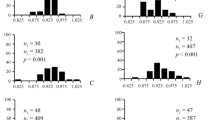Abstract
Natural populations of the landsnailTheba pisana (Pulmonata: Helicidae) were studied in the Mediterranean coastal plains of Israel. The life cycle is annual. Egg-laying occurs in the winter and the descendants grow fast during the spring, except for a part of the population the ceases growing. These individuals, termed “infantiles”, retain immature size and shape and a rudimentary status of the genital system. The percentage of infantilism in the population is positively related to the density of the snail population in the winter, and is negatively related to the humidity of weather in the spring. A natural control mechanism ofT. pisana populations is proposed: (a) in a dense population of young snails infantilism prevents most of them from becoming parents and an over-sized population the following year; (b) in a humid spring a fall in the rate of infantilism enlarges the population size, thus compensating for reduced egg-laying in winter.
Similar content being viewed by others
References
Berrie AD, Visser SA (1963) Investigations of a growth-inhibiting substance affecting a natural population of freshwater snails. Physiol Zool 36:167–173
Cameron RAD, Carter MA (1979) Intra- and interspecific effects of population density on growth and activity in some helicid land snails (Gastropada: Pulmonata). J Anim Ecol 48:237–246
Cowie RH (1980) Precocious breeding ofTheba pisana (Müller) (Pulmonata: Helicidae). J Conchol 30:238
Cowie RH (1984) The life-cycle and productivity of the land snailTheba pisana (Mollusca: Helicidae). J Anim Ecol 53:311–325
Dan N, Bailey SER (1982) Growth, mortality and feeding rates of the snailHelix aspersa at different population densities in the laboratory, and the depression of activity of helicid snails by other individuals, or their mucus. J Molluscan Stud 48:257–265
Dixon WJ, Massey FJ, Jr (1969) Introduction to statistical analysis. Mc Graw Hill, New York
Goodfriend GA (1986) Variation in land-snail shell form and size and its causes: a review. Syst Zool 35:204–223
Harpaz I, Oseri Y (1961) Crop-damaging snails in Israel and their control. Hebrew University of Jerusalem, Faculty of Agriculture, Rehovot, and Citrus Marketing Board, Agricultural Department, Tel-Aviv
Heller J (1982) Natural history ofTheba pisana in Israel (Pulmonata: Helicidae). J Zool 196:475–487
Lazaridou-Dimitriadou M, Daguzan J (1981) Etude de l'effet du ”groupment” des individus chezTheba pisana (Mollusque Gastropode Pulmone Stylommatophore). Malacologia 20:195–204
Moran S (1984) Seasonal variation and evironmental influence on the population structure of the landsnailTheba pisana (Müller 1774). Ph.D. Thesis, Tel-Aviv University
Oosterhoff LM (1977) Variation in growth rate as an ecological factor in the landsnailCepaea nemoralis (L.). Netherlands J Zool 27:1–132
Pomeroy OE, Laws HM (1967) The distribution of introduced snails in South Australia. Rec S Aust Mus 15:483–494
Sacchi CF (1971) Écologie comparée des Gastéropodes Pulmonés des dunes Méditerranéennes et Atlantiques. Natura, Milano 62:277–358
Shachak M, Phillips NJA (1971) Some ecological studies on the orientation in space and time for the activities of two species of desert snails,Sphincterochila boissieri andHelicella seetzeni. Midrashat Sde-Boker, Israel, pp 1–58
Taylor JW (1912)Helix pisana Müller. In: Monograph of the land and freshwater Mollusca of the British Isles, part 19. Taylor Brothers, Leeds, pp 368–397
Williamson P, Cameron RAD, Carter MA (1976) Population density affecting adult shell size of snailCepaea nemoralis L. Nature 263:496–497
Wolda H (1970a) Variation in growth rate in the landsnailCepaea nemoralis. Res Popul Ecol 12:185–204
Wolda H (1970b) Ecological variation and its implication for the dynamics of populations of the landsnailCepaea nemoralis. Proc Adv Study Inst Dynamics Numbers Popul, Oosterbeek, pp 98–108
Author information
Authors and Affiliations
Rights and permissions
About this article
Cite this article
Moran, S. Weather- and population density-induced infantilism in the landsnailTheba pisana in a semi-arid climate. Int J Biometeorol 33, 101–108 (1989). https://doi.org/10.1007/BF01686286
Received:
Revised:
Accepted:
Issue Date:
DOI: https://doi.org/10.1007/BF01686286




